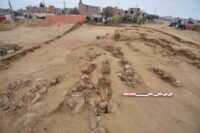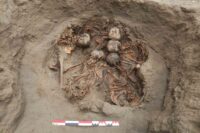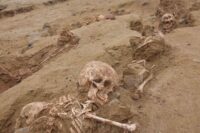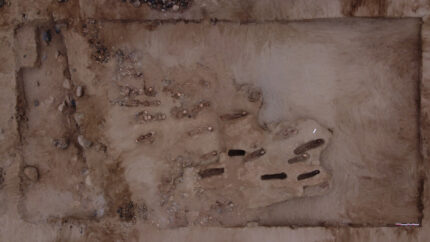 The remains of 76 more sacrificed children have been found at the pre-Hispanic Chimú Empire site of Pampa la Cruz in the beach town of Huanchaco on the northern coast of Peru. All of them had transversal cuts across the sternum, indicating the rib cages were opened to extract the hearts.
The remains of 76 more sacrificed children have been found at the pre-Hispanic Chimú Empire site of Pampa la Cruz in the beach town of Huanchaco on the northern coast of Peru. All of them had transversal cuts across the sternum, indicating the rib cages were opened to extract the hearts.
Huanchaco was part of the Chimú kingdom from the mid-9th century until it was conquered by the Inca in 1470. It was the main port of the Chimú capital of Chan Chan. It must have also held great religious significance, as this is only the most recent discovery of scores of sacrifice victims at Huanchaco. So far the remains of 302 children have been unearthed at Pampa la Cruz alone, making it the largest child sacrifice site ever discovered. More than 140 child sacrifices have been discovered at the neighboring site of Las Llamas.
 The 76 recently-unearthed graves were found in two artificial mounds, 25 graves in Mound 1 and 51 in Mound 2. Most of them are oriented with the feet pointing east and heads west, their backs to the sea. Archaeologists believe they were sacrificed to consecrate a new irrigation system in newly-planted agricultural fields near the site. One significant find deviates from this pattern. A grave in Mound 1 contained the remains of five female bodies arranged head to head in a kind of spiral circle. This unusual configuration has not been seen before in the excavations of the mass sacrifices at Pampa la Cruz.
The 76 recently-unearthed graves were found in two artificial mounds, 25 graves in Mound 1 and 51 in Mound 2. Most of them are oriented with the feet pointing east and heads west, their backs to the sea. Archaeologists believe they were sacrificed to consecrate a new irrigation system in newly-planted agricultural fields near the site. One significant find deviates from this pattern. A grave in Mound 1 contained the remains of five female bodies arranged head to head in a kind of spiral circle. This unusual configuration has not been seen before in the excavations of the mass sacrifices at Pampa la Cruz.
The sacrifices were done in phases, not all at once. Archaeologists have found evidence of six mass  sacrifice events that took place at the site. These sacrifices are believed to have been associated with agricultural practices in the beginning, but then in later events the sacrifices appear to be connected to major milestones in the rise of the Chimú Empire. The first two events, both seemingly related to crop cultivation, took place between 1050 and 1200 A.D. The third dates to between 1200 and 1300 A.D., a period wherein the Chimú empire expanded. The children buried in this phase were elaborately garbed in robes and feathered headdresses. Events four and five took place between 1300 and 1450, the pinnacle of Chimú territorial reach and splendor. The children buried in these stages wore loincloths, white shirts and turbans. The last event occurred between 1450 and 1500, after the Chimú had fallen to the Incas.
sacrifice events that took place at the site. These sacrifices are believed to have been associated with agricultural practices in the beginning, but then in later events the sacrifices appear to be connected to major milestones in the rise of the Chimú Empire. The first two events, both seemingly related to crop cultivation, took place between 1050 and 1200 A.D. The third dates to between 1200 and 1300 A.D., a period wherein the Chimú empire expanded. The children buried in this phase were elaborately garbed in robes and feathered headdresses. Events four and five took place between 1300 and 1450, the pinnacle of Chimú territorial reach and splendor. The children buried in these stages wore loincloths, white shirts and turbans. The last event occurred between 1450 and 1500, after the Chimú had fallen to the Incas.
